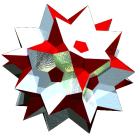snub decahecatonicosachoron,
compound of 10 ex in hi army,
compound of 2 spohi
©
©
o2x f2f F2o x2F F2o f2f o2x
o2f F2F B2o f2B B2o F2F o2f
o2o f2F B2f F2B oC2Co F2B B2f f2F o2o
f2o F2f Bx2xB f2C Co2FD B2B D2f B2B Co2FD f2C Bx2xB F2f f2o
x2o F2F f2B C2f FD2DF B2C o2T T2x o2T B2C FD2DF C2f f2B F2F x2o
f2f o2B B2F FD2Co C2B fT2Tf B2D fT2Tf C2B FD2Co B2F o2B f2f
o2F B2B T2o F2T T2o B2B o2F
F2x B2f oC2Co f2D x2T D2B T2F C2C T2F D2B x2T f2D oC2Co B2f F2x
o2F B2B T2o F2T T2o B2B o2F
f2f o2B B2F FD2Co C2B fT2Tf B2D fT2Tf C2B FD2Co B2F o2B f2f
x2o F2F f2B C2f FD2DF B2C o2T T2x o2T B2C FD2DF C2f f2B F2F x2o
f2o F2f Bx2xB f2C Co2FD B2B D2f B2B Co2FD f2C Bx2xB F2f f2o
o2o f2F B2f F2B oC2Co F2B B2f f2F o2o
o2f F2F B2o f2B B2o F2F o2f
o2x f2f F2o x2F F2o f2f o2x
|
hull = hi (F=ff=f+x, V=2f, B=fff=F+f=2f+x, C=B+x=2F=2f, D=C+v=3f+x, T=FF=3f+2x) |
f2f f2f
F2F F2F
o2o oC2Co o2o
Bx2xB B2B B2B Bx2xB
F2F FD2DF FD2DF F2F
f2f fT2Tf fT2Tf f2f
B2B B2B
oC2Co C2C oC2Co
B2B B2B
f2f fT2Tf fT2Tf f2f
F2F FD2DF FD2DF F2F
Bx2xB B2B B2B Bx2xB
o2o oC2Co o2o
F2F F2F
f2f f2f
|
vertex-inscribed non-uniform 2 ex compound, infact 5 such components then build this uniform compound. scaling factor = fq = sqrt[3+sqrt(5)] = 2.288246 (vertex figure highlighted) |
o2o
o2x f2o x2f f2o o2x
x2o f2f o2F F2x o2F f2f x2o
o2f F2o f2F F2o o2f
o2o f2x x2F F2f Vo2oV F2f x2F f2x o2o
o2f F2o f2F F2o o2f
x2o f2f o2F F2x o2F f2f x2o
o2x f2o x2f f2o o2x
o2o
|
single ex component (display just slanted by 360°/8=45°) |
links
